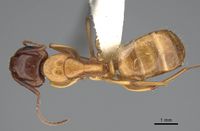Camponotus keiferi
| Camponotus keiferi | |
|---|---|

| |
| Scientific classification | |
| Kingdom: | Animalia |
| Phylum: | Arthropoda |
| Class: | Insecta |
| Order: | Hymenoptera |
| Family: | Formicidae |
| Subfamily: | Formicinae |
| Tribe: | Camponotini |
| Genus: | Camponotus |
| Species: | C. keiferi |
| Binomial name | |
| Camponotus keiferi Wheeler, W.M., 1934 | |
Identification
This form closely resembles Camponotus castaneus of our Eastern States but is quite distinct, being much smaller, with a narrower head, distinct metanotal sclerite in the major worker, a much more acute petiole, no bristles on the flexor surfaces of the hind and middle tibiae, etc. (Wheeler 1934)
Distribution
Latitudinal Distribution Pattern
Latitudinal Range: 32.066389° to 28.91666667°.
| North Temperate |
North Subtropical |
Tropical | South Subtropical |
South Temperate |
- Source: AntMaps
Distribution based on Regional Taxon Lists
Neotropical Region: Mexico (type locality).
Distribution based on AntMaps
Distribution based on AntWeb specimens
Check data from AntWeb
Countries Occupied
| Number of countries occupied by this species based on AntWiki Regional Taxon Lists. In general, fewer countries occupied indicates a narrower range, while more countries indicates a more widespread species. |

|
Estimated Abundance
| Relative abundance based on number of AntMaps records per species (this species within the purple bar). Fewer records (to the left) indicates a less abundant/encountered species while more records (to the right) indicates more abundant/encountered species. |

|
Biology
Castes
Nomenclature
The following information is derived from Barry Bolton's Online Catalogue of the Ants of the World.
- keiferi. Camponotus (Camponotus) keiferi Wheeler, W.M. 1934f: 137 (s.w.) MEXICO (Baja California: Guadalupe I.).
- Status as species: Wheeler, W.M. 1935g: 39; Bolton, 1995b: 106.
Unless otherwise noted the text for the remainder of this section is reported from the publication that includes the original description.
Description
minor Length 5.5-6 mm.
Very similar to the major, except in having the head smaller and narrower, though with anteriorly converging sides, with straight posterior border, larger and more convex eyes, more convex and more distinctly subcarinate clypeus, proportionally longer antennal scapes, less sigmoidal frontal carinae. Pilosity, sculpture and color as in the major, but the head is more shining anteriorly, with less distinct punctures, the gaster darker brown.
major Length 7-8 mm.
Head rather small, subtrapezoidal, longer than broad, narrowed anteriorly, with straight sides and feebly and broadly excavated posterior border. Eyes moderately large and convex. Mandibles stout and convex, 6-toothed. Clypeus subcarinate at the base, its anterior border neither lobed nor produced, slightly emarginate in the middle. Frontal area small, transversely trapezoidal, frontal groove distinct; frontal carinae sigmoidal. Antennal scapes extending nearly two-fifths of their length beyond the posterior corners of the head, slender and feebly flattened but not dilated at the base. Thorax of the usual shape, the pronotum, mesonotum and base of the epinotum forming an even curve in profile; pronotum flattened above, anteriorly semicircular, submarginate at the sides; metanotal sclerite distinct, bounded by a, suture posteriorly; epinotum strongly compressed laterally, in profile with the base straight and rather strongly sloping, forming a distinct obtuse angle with the slightly shorter, perpendicular and somewhat concave declivity. Petiolar scale rather broad, convex both anteriorly and posteriorly, the superior border not very acute, from behind feebly convex as are also the lateral borders. Legs moderately long, fore femora enlarged; hind tibiae somewhat flattened but not grooved, their flexor surfaces without bristles.
Smooth and shining, microscopically shagreened and with small, sparse, piligerous punctures; anterior portion of head less shining and distinctly though minutely and densely punctulate, clypeus and adjacent portions of cheeks also with sparse piligerous foveolae, the more posterior portions of cheeks with small, nonpiligerous punctures. Mandibles sharply punctate; antennal scapes subopaque, finely punctulate.
Hairs golden yellow, moderately long, very sparse, erect, absent on the scapes and legs, except at tips of femora. Pubescence undeveloped, except on the tibiae, where it is extremely fine and appressed.
Brownish yellow; gaster brown above; head, mandibles and scapes castaneous; funiculi red; mandibular teeth black; coxae, femora and palpi yellow; knees, tibiae and tarsi somewhat darker and more reddish; posterior borders of gastric segments yellowish.
Type Material
Described from four major and two minor workers taken on the south end of Guadalupe Island (IV.20.'25).
References
- Alatorre-Bracamontes, C.E., Vásquez-Bolaños, M. 2010. Lista comentada de las hormigas (Hymenoptera: Formicidae) del norte de México. Dugesiana 17(1): 9-36.
- Wheeler, W. M. 1934d. Contributions to the fauna of Rottnest Island, Western Australia. No. IX. The ants. J. R. Soc. West. Aust. 20: 137-163 (page 137, soldier, worker described)
References based on Global Ant Biodiversity Informatics
- Dattilo W. et al. 2019. MEXICO ANTS: incidence and abundance along the Nearctic-Neotropical interface. Ecology https://doi.org/10.1002/ecy.2944
- Johnson, R.A. and P.S. Ward. 2002. Biogeography and endemism of ants (Hymenoptera: Formicidae) in Baja California, Mexico: a first overview. Journal of Biogeography 29:10091026/
- Vásquez-Bolaños M. 2011. Lista de especies de hormigas (Hymenoptera: Formicidae) para México. Dugesiana 18: 95-133

